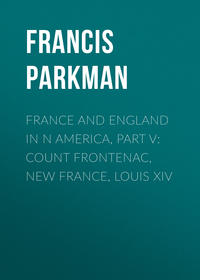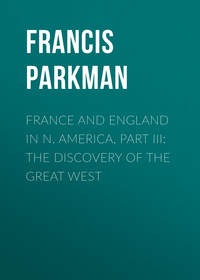 полная версия
полная версияA Half-Century of Conflict - Volume II
This ominous beginning was followed by a train of disasters. His associates abandoned him; the merchants on whom he depended for supplies would not send them, and he found himself, in his own words "destitute of everything." His nephew, La Jemeraye, died. The Jesuit Auneau, bent on returning to Michillimackinac, set out with La Vérendrye's eldest son and a party of twenty Canadians. A few days later, they were all found on an island in the Lake of the Woods, murdered and mangled by the Sioux. [Footnote: Beauharnois au Ministre, 14 Oct. 1736; Relation du Massacre au Lac des Bois, en Juin, 1736; Journal de la Vérendrye, joint à la lettre de M. de Beauharnois du —— Oct. 1737.] The Assinniboins and Cristineaux, mortal foes of that fierce people, offered to join the French and avenge the butchery; but a war with the Sioux would have ruined La Vérendrye's plans of discovery, and exposed to torture and death the French traders in their country. Therefore he restrained himself and declined the proffered aid, at the risk of incurring the contempt of those who offered it.
Beauharnois twice appealed to the court to give La Vérendrye some little aid, urging that he was at the end of his resources, and that a grant of 30,000 francs, or 6,000 dollars, would enable him to find a way to the Pacific. All help was refused, but La Vérendrye was told that he might let out his forts to other traders, and so raise means to pursue the discovery.
In 1740 he went for the third time to Montreal, where, instead of aid, he found a lawsuit. "In spite," he says, "of the derangement of my affairs, the envy and jealousy of various persons impelled them to write letters to the court insinuating that I thought of nothing but making my fortune. If more than forty thousand livres of debt which I have on my shoulders are an advantage, then I can flatter myself that I am very rich. In all my misfortunes, I have the consolation of seeing that M. de Beauharnois enters into my views, recognizes the uprightness of my intentions, and does me justice in spite of opposition." [Footnote: Mémoire du Sieur de la Vérendrye au sujet des Etablissements pour parvenir à la Découverte de la Mer de l'Quest.]
Meanwhile, under all his difficulties, he had explored a vast region hitherto unknown, diverted a great and lucrative fur-trade from the English at Hudson Bay, and secured possession of it by six fortified posts,—Fort St. Pierre, on Rainy Lake; Fort St. Charles, on the Lake of the Woods; Fort Maurepas, at the mouth of the river Winnipeg; Fort Bourbon, on the eastern side of Lake Winnipeg; Fort La Reine, on the Assinniboin; Fort Dauphin, on Lake Manitoba. Besides these he built another post, called Fort Rouge, on the site of the city of Winnipeg; and, some time after, another, at the mouth of the River Poskoiac, or Saskatchawan, neither of which, however, was long occupied. These various forts were only stockade works flanked with block-houses; but the difficulty of building and maintaining them in this remote wilderness was incalculable. [Footnote: Mémoire en abrégé de la Carte qui représente les Etablissements faits par le Sieur de la Vérendrye et ses Enfants (Margry, VI. 616); Carte des Nouvelles Découvertes dans l'Ouest du Canada dressée sur les Mémoires de Mr. de la Vérandrie et donnée au Dépôt de la Marine par M. de la Galissonnière, 1750; Bellin, Remarques surla Carte de l'Amérique, 1755; Bougainville, _Mémoire sur l'Etat de la Nouvelle France, _1757. Most of La Vérendrye's forts were standing during the Seven Years' War, and were known collectively as Postes de la Mer de l'Ouest.]
He had inquired on all sides for the Pacific. The Assinniboins could tell him nothing. Nor could any information be expected from them, since their relatives and mortal enemies, the Sioux, barred their way to the West. The Cristineaux were equally ignorant; but they supplied the place of knowledge by invention, and drew maps, some of which seem to have been made with no other intention than that of amusing themselves by imposing on the inquirer. They also declared that some of their number had gone down a river called White River, or River of the West, where they found a plant that shed drops like blood, and saw serpents of prodigious size. They said further that on the lower part of this river were walled towns, where dwelt white men who had knives, hatchets, and cloth, but no firearms. [Footnote: Journal de la Vérendrye joint à la Lettre de M. de Beauharnois du —— Oct. 1737.]
Both Assinniboins and Cristineaux declared that there was a distant tribe on the Missouri, called Mantannes (Mandans), who knew the way to the Western Sea, and would guide him to it. Lured by this assurance, and feeling that he had sufficiently secured his position to enable him to begin his Western exploration, La Vérendrye left Fort La Reine in October, 1738, with twenty men, and pushed up the River Assinniboin till its rapids and shallows threatened his bark canoes with destruction. Then, with a band of Assinniboin Indians who had joined him, he struck across the prairie for the Mandans, his Indian companions hunting buffalo on the way. They approached the first Mandan village on the afternoon of the 3d of December, displaying a French flag and firing three volleys as a salute. The whole population poured out to see the marvellous visitors, who were conducted through the staring crowd to the lodge of the principal chief,—a capacious structure so thronged with the naked and greasy savages that the Frenchmen were half smothered. What was worse, they lost the bag that held all their presents for the Mandans, which was snatched away in the confusion, and hidden in one of the caches, called cellars by La Vérendrye, of which the place was full. The chief seemed much discomposed at this mishap, and explained it by saying that there were many rascals in the village. The loss was serious, since without the presents nothing could be done. Nor was this all; for in the morning La Vérendrye missed his interpreter, and was told that he had fallen in love with an Assinniboin girl and gone off in pursuit of her. The French were now without any means of communicating with the Mandans, from whom, however, before the disappearance of the interpreter, they had already received a variety of questionable information, chiefly touching white men cased in iron who were said to live on the river below at the distance of a whole summer's journey. As they were impervious to arrows,—so the story ran,—it was necessary to shoot their horses, after which, being too heavy to run, they were easily caught. This was probably suggested by the armor of the Spaniards, who had more than once made incursions as far as the lower Missouri; but the narrators drew on their imagination for various additional particulars.
The Mandans seem to have much declined in numbers during the century that followed this visit of La Vérendrye. He says that they had six villages on or near the Missouri, of which the one seen by him was the smallest, though he thinks that it contained a hundred and thirty houses. [Footnote: Journal de la Vérendrye, 1738,1739. This journal, which is ill-written and sometimes obscure, is printed in Brymner, Report on Canadian Archives, 1889.] As each of these large structures held a number of families, the population must have been considerable. Yet when Prince Maximilian visited the Mandans in 1833, he found only two villages, containing jointly two hundred and forty warriors and a total population of about a thousand souls. Without having seen the statements of La Vérendrye, he speaks of the population as greatly reduced by wars and the small-pox,—a disease which a few years later nearly exterminated the tribe. [Footnote: Le Prince Maximilien de Wied-Neuwied, Voyage dans l'Intérieur de l'Amérique du Nord, II. 371, 372 (Paris, 1843). When Captains Lewis and Clark visited the Mandans in 1804, they found them in two villages, with about three hundred and fifty warriors. They report that, about forty years before, they lived in nine villages, the ruins of which the explorers saw about eighty miles below the two villages then occupied by the tribe. The Mandans had moved up the river in consequence of the persecutions of the Sioux and the small-pox, which had made great havoc among them. Expedition of Lewis and Clark, I. 129 (ed. Philadelphia, 1814).These nine villages seem to have been above Cannon-ball River, a tributary of the Missouri.]
La Vérendrye represents the six villages as surrounded with ditches and stockades, flanked by a sort of bastion,—defences which, he says, had nothing savage in their construction. In later times the fortifications were of a much ruder kind, though Maximilian represents them as having pointed salients to serve as bastions. La Vérendrye mentions some peculiar customs of the Mandans which answer exactly to those described by more recent observers.
He had intended to winter with the tribe; but the loss of the presents and the interpreter made it useless to stay, and leaving two men in the village to learn the language, he began his return to Fort La Reine. "I was very ill," he writes, "but hoped to get better on the way. The reverse was the case, for it was the depth of winter. It would be impossible to suffer more than I did. It seemed that nothing but death could release us from such miseries." He reached Fort La Reine on the 11th of February, 1739.
His iron constitution seems to have been severely shaken; but he had sons worthy of their father. The two men left among the Mandans appeared at Fort La Reine in September. They reported that they had been well treated, and that their hosts had parted from them with regret. They also declared that at the end of spring several Indian tribes, all well supplied with horses, had come, as was their yearly custom, to the Mandan villages to barter embroidered buffalo hides and other skins for corn and beans; that they had encamped, to the number of two hundred lodges, on the farther side of the Missouri, and that among them was a band said to have come from a distant country towards the sunset, where there were white men who lived in houses built of bricks and stones.
The two Frenchmen crossed over to the camp of these Western strangers, among whom they found a chief who spoke, or professed to speak, the language of the mysterious white men, which to the two Frenchmen was unintelligible. Fortunately, he also spoke the language of the Mandans, of which the Frenchmen had learned a little during their stay, and hence were able to gather that the white men in question had beards, and that they prayed to the Master of Life in great houses, built for the purpose, holding books, the leaves of which were like husks of Indian corn, singing together and repeating Jésus, Marie. The chief gave many other particulars, which seemed to show that he had been in contact with Spaniards,—probably those of California; for he described their houses as standing near the great lake, of which the water rises and falls and is not fit to drink. He invited the two Frenchmen to go with him to this strange country, saying that it could be reached before winter, though a wide circuit must be made, to avoid a fierce and dangerous tribe called Snake Indians (Gens du Serpent). [Footnote: Journal du Sieur de la Vérendrye, 1740, in Archives de la Marine.]
On hearing this story, La Vérendrye sent his eldest son, Pierre, to pursue the discovery with two men, ordering him to hire guides among the Mandans and make his way to the Western Sea. But no guides were to be found, and in the next summer the young man returned from his bootless errand. [Footnote: Mémoire du Sieur de la Vérendrye, joint à sa lettre du 31 Oct. 1744]
Undaunted by this failure, Pierre set out again in the next spring, 1742, with his younger brother, the Chevalier de la Vérendrye. Accompanied only by two Canadians, they left Port La Reine on the 29th of April, and following, no doubt, the route of the Assinniboin and Mouse River, reached the chief village of the Mandans in about three weeks.
Here they found themselves the welcome guests of this singularly interesting tribe, ruined by the small-pox nearly half a century ago, but preserved to memory by the skilful pencil of the artist Charles Bodmer, and the brush of the painter George Catlin, both of whom saw them at a time when they were little changed in habits and manners since the visit of the brothers La Vérendrye. [Footnote: Prince Maximilian spent the winter of 1832-33 near the Mandan villages. His artist, with the instinct of genius, seized the characteristics of the wild life before him, and rendered them with admirable vigor and truth. Catlin spent a considerable time among the Mandans soon after the visit of Prince Maximilian, and had unusual opportunities of studying them. He was an indifferent painter, a shallow observer, and a garrulous and windy writer; yet his enthusiastic industry is beyond praise, and his pictures are invaluable as faithful reflections of aspects of Indian life which are gone forever.]
[Footnote: Beauharnois calls the Mandans Blancs Barbus, and says that they have been hitherto unknown. Beauharnois au Ministre, 14 Août, 1739. The name Mantannes, or Mandans, is that given them by the Assinniboins.]
Thus, though the report of the two brothers is too concise and brief, we know what they saw when they entered the central area, or public square, of the village. Around stood the Mandan lodges, looking like round flattened hillocks of earth, forty or fifty feet wide. On examination they proved to be framed of strong posts and poles, covered with a thick matting of intertwined willow-branches, over which was laid a bed of well-compacted clay or earth two or three feet thick. This heavy roof was supported by strong interior posts. [Footnote: The Minnetarees and other tribes of the Missouri built their lodges in a similar way.] The open place which the dwellings enclosed served for games, dances, and the ghastly religious or magical ceremonies practised by the tribe. Among the other structures was the sacred "medicine lodge" distinguished by three or four tall poles planted before it, each surmounted by an effigy looking much like a scarecrow, and meant as an offering to the spirits.
If the two travellers had been less sparing of words, they would doubtless have told us that as they entered the village square the flattened earthen domes that surrounded it were thronged with squaws and children,—for this was always the case on occasions of public interest,—and that they were forced to undergo a merciless series of feasts in the lodges of the chiefs. Here, seated by the sunken hearth in the middle, under the large hole in the roof that served both for window and chimney, they could study at their ease the domestic economy of their entertainers. Each lodge held a gens, or family connection, whose beds of raw buffalo hide, stretched on poles, were ranged around the circumference of the building, while by each stood a post on which hung shields, lances, bows, quivers, medicine-bags, and masks formed of the skin of a buffalo's head, with the horns attached, to be used in the magic buffalo dance.
Every day had its sports to relieve the monotony of savage existence, the game of the stick and the rolling ring, the archery practice of boys, horse-racing on the neighboring prairie, and incessant games of chance; while every evening, in contrast to these gayeties, the long, dismal wail of women rose from the adjacent cemetery, where the dead of the village, sewn fast in buffalo hides, lay on scaffolds above the reach of wolves.
The Mandans did not know the way to the Pacific, but they told the brothers that they expected a speedy visit from a tribe or band called Horse Indians, who could guide them thither. It is impossible to identify this people with any certainty. [Footnote: The Cheyennes have a tradition that they were the first tribe of this region to have horses. This may perhaps justify a conjecture that the northern division of this brave and warlike people were the Horse Indians of La Vérendrye; though an Indian tradition, unless backed by well-established facts, can never be accepted as substantial evidence.] The two travellers waited for them in vain till after midsummer, and then, as the season was too far advanced for longer delay, they hired two Mandans to conduct them to their customary haunts.
They set out on horseback, their scanty baggage and their stock of presents being no doubt carried by pack-animals. Their general course was west-southwest, with the Black Hills at a distance on their left, and the upper Missouri on their right. The country was a rolling prairie, well covered for the most part with grass, and watered by small alkaline streams creeping towards the Missouri with an opaque, whitish current. Except along the watercourses, there was little or no wood. "I noticed," says the Chevalier de la Vérendrye, "earths of different colors, blue, green, red, or black, white as chalk, or yellowish like ochre." This was probably in the "bad lands" of the Little Missouri, where these colored earths form a conspicuous feature in the bare and barren bluffs, carved into fantastic shapes by the storms. [Footnote: A similar phenomenon occurs farther west on the face of the perpendicular bluffs that, in one place, border the valley of the river Rosebud.]
For twenty days the travellers saw no human being, so scanty was the population of these plains. Game, however, was abundant. Deer sprang from the tall, reedy grass of the river bottoms; buffalo tramped by in ponderous columns, or dotted the swells of the distant prairie with their grazing thousands; antelope approached, with the curiosity of their species, to gaze at the passing horsemen, then fled like the wind; and as they neared the broken uplands towards the Yellowstone, they saw troops of elk and flocks of mountain-sheep. Sometimes, for miles together, the dry plain was studded thick with the earthen mounds that marked the burrows of the curious marmots, called prairie-dogs, from their squeaking bark. Wolves, white and gray, howled about the camp at night, and their cousin, the coyote, seated in the dusk of evening upright on the grass, with nose turned to the sky, saluted them with a complication of yelpings, as if a score of petulant voices were pouring together from the throat of one small beast.
On the 11th of August, after a march of about three weeks, the brothers reached a hill, or group of hills, apparently west of the Little Missouri, and perhaps a part of the Powder River Range. It was here that they hoped to find the Horse Indians, but nobody was to be seen. Arming themselves with patience, they built a hut, made fires to attract by the smoke any Indians roaming near, and went every day to the tops of the hills to reconnoitre. At length, on the 14th of September, they descried a spire of smoke on the distant prairie.
One of their Mandan guides had left them and gone back to his village. The other, with one of the Frenchmen, went towards the smoke, and found a camp of Indians, whom the journal calls Les Beaux Hommes, and who were probably Crows, or Apsaroka, a tribe remarkable for stature and symmetry, who long claimed that region as their own. They treated the visitors well, and sent for the other Frenchmen to come to their lodges, where they were received with great rejoicing. The remaining Mandan, however, became frightened,—for the Beaux Hommes were enemies of his tribe,—and he soon followed his companion on his solitary march homeward.
The brothers remained twenty-one days in the camp of the Beaux Hommes, much perplexed for want of an interpreter. The tribes of the plains have in common a system of signs by which they communicate with each other, and it is likely that the brothers had learned it from the Sioux or Assinniboins, with whom they had been in familiar intercourse. By this or some other means they made their hosts understand that they wished to find the Horse Indians; and the Beaux Hommes, being soothed by presents, offered some of their young men as guides. They set out on the 9th of October, following a south-southwest course. [Footnote: Journal du Voyage fait par le Chevalier de la Vérendrye en 1742. The copy before me is from the original in the Depot des Cartes de la Marine. A duplicate, in the Archives des Affaires Etrangères, is printed by Margry. It gives the above date as November 9th instead of October 9th. The context shows the latter to be correct.]
In two days they met a band of Indians, called by them the Little Foxes, and on the 15th and 17th two villages of another unrecognizable horde, named Pioya. From La Vérendrye's time to our own, this name "villages" has always been given to the encampments of the wandering people of the plains. All these nomadic communities joined them, and they moved together southward, till they reached at last the lodges of the long-sought Horse Indians. They found them in the extremity of distress and terror. Their camp resounded with howls and wailings; and not without cause, for the Snakes, or Shoshones,—a formidable people living farther westward,—had lately destroyed most of their tribe. The Snakes were the terror of that country. The brothers were told that the year before they had destroyed seventeen villages, killing the warriors and old women, and carrying off the young women and children as slaves.
None of the Horse Indians had ever seen the Pacific; but they knew a people called Gens de l'Arc, or Bow Indians, who, as they said, had traded not far from it. To the Bow Indians, therefore, the brothers resolved to go, and by dint of gifts and promises they persuaded their hosts to show them the way. After marching southwestward for several days, they saw the distant prairie covered with the pointed buffalo-skin lodges of a great Indian camp. It was that of the Bow Indians, who may have been one of the bands of the western Sioux,—the predominant race in this region. Few or none of them could ever have seen a white man, and we may imagine their amazement at the arrival of the strangers, who, followed by staring crowds, were conducted to the lodge of the chief. "Thus far," says La Vérendrye, "we had been well received in all the villages we had passed; but this was nothing compared with the courteous manners of the great chief of the Bow Indians, who, unlike the others, was not self-interested in the least, and who took excellent care of everything belonging to us."
The first inquiry of the travellers was for the Pacific; but neither the chief nor his tribesmen knew anything of it, except what they had heard from Snake prisoners taken in war. The Frenchmen were surprised at the extent of the camp, which consisted of many separate bands. The chief explained that they had been summoned from far and near for a grand war-party against that common foe of all,—the Snakes. [Footnote: The enmity between the Sioux and the Snakes lasted to our own time. When the writer lived among the western Sioux, one of their chiefs organized a war-party against the Snakes, and numerous bands came to join the expedition from a distance in some cases of three hundred miles. Quarrels broke out among them, and the scheme was ruined.] In fact, the camp resounded with war-songs and war-dances. "Come with us," said their host; "we are going towards the mountains, where you can see the great water that you are looking for."
At length the camp broke up. The squaws took down the lodges, and the march began over prairies dreary and brown with the withering touch of autumn. The spectacle was such as men still young have seen in these Western lands, but which no man will see again. The vast plain swarmed with the moving multitude. The tribes of the Missouri and the Yellowstone had by this time abundance of horses, the best of which were used for war and hunting, and the others as beasts of burden. These last were equipped in a peculiar manner. Several of the long poles used to frame the teepees, or lodges, were secured by one end to each side of a rude saddle, while the other end trailed on the ground. Crossbars lashed to the poles just behind the horse kept them three or four feet apart, and formed a firm support, on which was laid, compactly folded, the buffalo-skin covering of the lodge. On this, again, sat a mother with her young family, sometimes stowed for safety in a large open willow basket, with the occasional addition of some domestic pet,—such as a tame raven, a puppy, or even a small bear cub. Other horses were laden in the same manner with wooden bowls, stone hammers, and other utensils, along with stores of dried buffalo-meat packed in cases of rawhide whitened and painted. Many of the innumerable dogs—whose manners and appearance strongly suggested their relatives the wolves, to whom, however, they bore a mortal grudge—were equipped in a similar way, with shorter poles and lighter loads. Bands of naked boys, noisy and restless, roamed the prairie, practising their bows and arrows on any small animal they might find. Gay young squaws—adorned on each cheek with a spot of ochre or red clay, and arrayed in tunics of fringed buckskin embroidered with porcupine quills—were mounted on ponies, astride like men; while lean and tattered hags—the drudges of the tribe, unkempt and hideous—scolded the lagging horses, or screeched at the disorderly dogs, with voices not unlike the yell of the great horned owl. Most of the warriors were on horseback, armed with round, white shields of bull-hide, feathered lances, war-clubs, bows, and quivers filled with stone-headed arrows; while a few of the elders, wrapped in robes of buffalo-hide, stalked along in groups with a stately air, chatting, laughing, and exchanging unseemly jokes. [Footnote: The above descriptive particulars are drawn from repeated observation of similar scenes at a time when the primitive condition of these tribes was essentially unchanged, though with the difference that the concourse of savages counted by hundreds, and not by thousands.]







